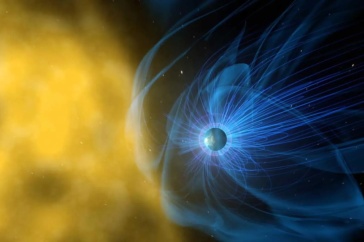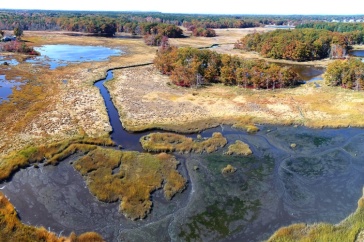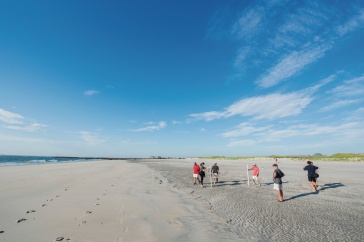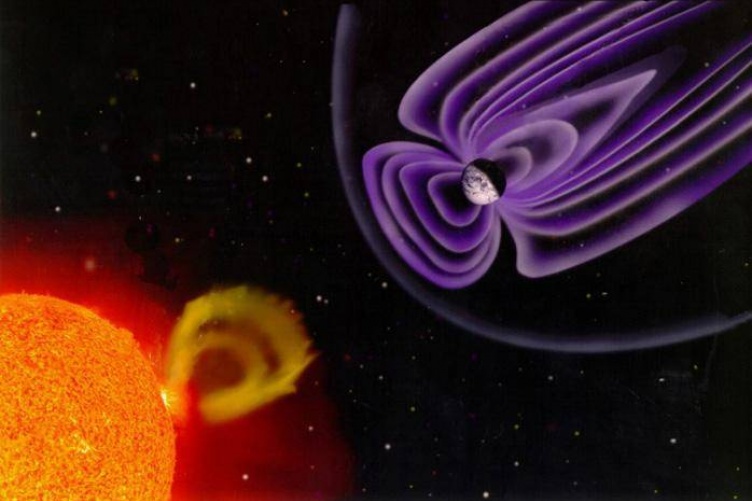
Image: NASA
What happens in space doesn’t stay in space, and that’s a problem for power companies here on Earth.
UNH scientists are involved in a four-year research project that utilizes artificial intelligence and student-built magnetometers to improve the forecasting of space weather events and help power companies prepare for the service outages those storms might cause.
"We are taking advantage of the recent explosion of machine learning and the availability of a few decades of data to apply to the GIC problem."
When our planet’s magnetic field is disturbed by radiation and charged particles from the sun, there are increased electrical currents flowing in the ionosphere that can induce currents on Earth; scientists call these geomagnetically induced currents (GICs). GICs seek out the path of least resistance for travel, and so they’ll frequently move via a long conductor, such as train tracks or power lines. This surge of electricity can wreak havoc on critical infrastructure and power supplies. Scientists are working to learn more about how space currents behave once they’re on Earth, while also expanding a program that teaches high school students how to monitor small changes in the Earth’s magnetic field.
The research project, funded by the National Science Foundation, is led by the University of Alaska, Fairbanks (UAF) in equal partnership with UNH, which received approximately $2 million for its part in the project. Amy Keesee, an associate professor in the UNH Space Science Center, is leading an interdisciplinary team to investigate GICs further.
Using AI For GICs
Now more than a year and a half into the project, the UNH research team has taken a deep dive into machine-learning algorithms — a type of artificial intelligence that uses statistics to find patterns in large amounts of data — to improve their understanding of the physics that cause GICs. In a nod to this focus, the team has dubbed itself MAGICIAN: Machine-learning Algorithms for GICs in Alaska and New Hampshire.

“Machine-learning techniques are relatively new to the field of geospace physics, so we spent some time learning about them and testing different techniques,” Keesee says. “We are taking advantage of the recent explosion of machine learning and the availability of a few decades of data to apply to the GIC problem.”
Team MAGICIAN has already published one paper from the project that compared two different types of AI neural networks to predict GICs, she adds.
Two of the MAGICIAN researchers — Md Shaad Mahmud, an assistant professor in electrical and computer engineering, and Jeremiah W. Johnson, an assistant professor of data science at UNH Manchester — are experts in machine-learning techniques and have been instrumental in finding creative ways to adapt them for the project. Johnson, along with UNH graduate student Swathi Hari, took a computer model called a transformer that was originally developed to help computers understand human languages and adapted it for GIC predictions.
“Our adaption of the transformer model to this context provides a very new and cutting-edge approach to predicting GICs,” Johnson says. In the coming year, he plans to refine the model in hopes of making accurate GIC predictions at least 30-60 minutes in advance, thus providing power companies with time to prepare and prevent an interruption of service.
Johnson also hopes that machine learning can be used to determine if there’s a correlation between aurora like the Northern Lights and GICs. The team will work with their colleagues at UAF this year to determine if models can predict GICs by using aurora imaging — a technique that records a particular wavelength of light that corresponds with specific atomic transitions that occur in the aurora, Keesee explains.
“Although enormous amounts of aurora imaging data exist, very little of it is labeled,” Johnson says. “So we’ve developed a semi-supervised learning algorithm that we are currently using to automatically label thousands of images at the Poker Flat Research Range collected over decades by the UAF team. Once this is complete, we can start looking into how the aurora images correlate with GICs.”
Going Underground to Detect Space Weather
Buried in the dirt all around the world lies a network of scientific instruments designed to detect changes in the Earth’s magnetic field. These magnetometers can measure deviations in the ground’s magnetic field that lead to GICs. Although these data are available to the public, the magnetometers themselves are spaced very far apart — less than one per state in the U.S. — leading to wide variations in the data.
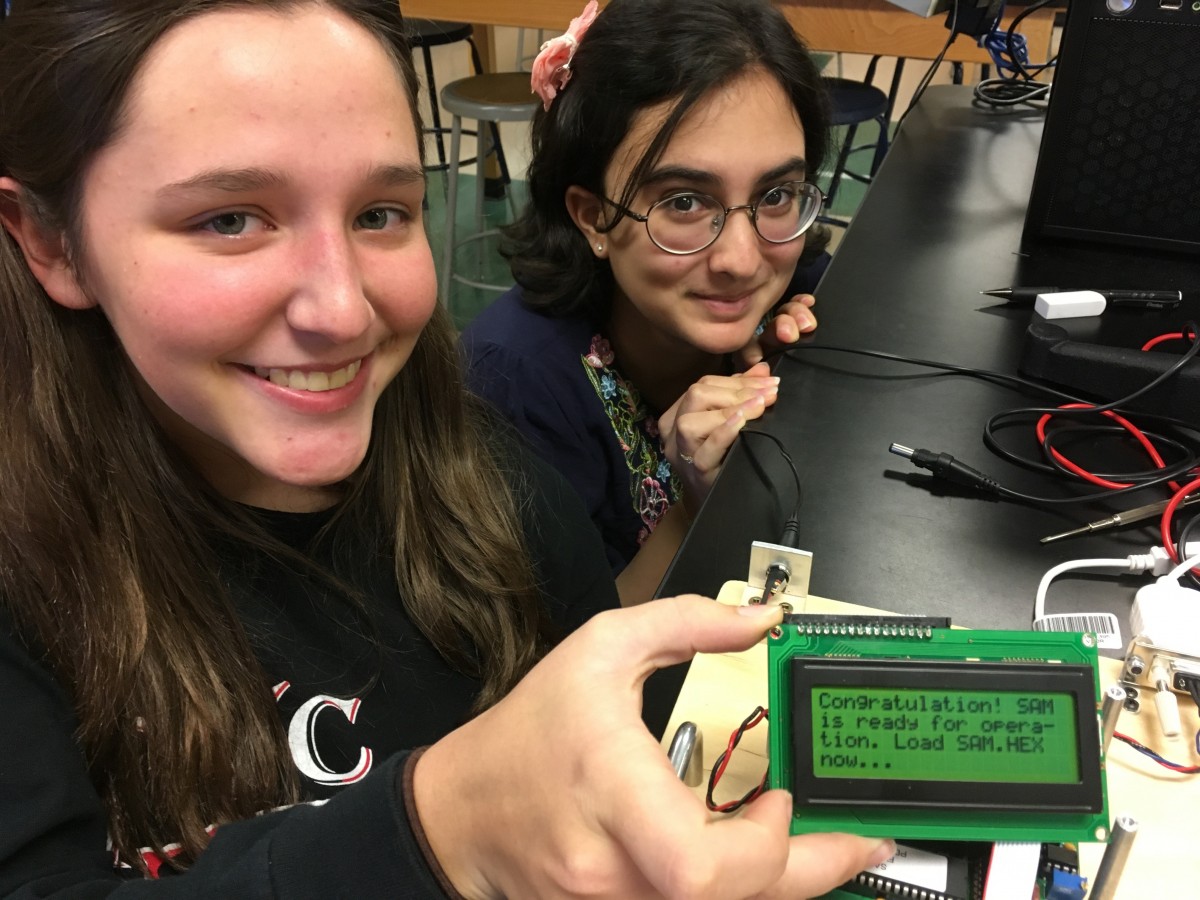
But all that is starting to change. Two of the Team MAGICIAN scientists — Charles Smith and Harald Kucharek, both research professors from the UNH Space Science Center — are leading a program called Space Weather Underground, where high school students and their teachers build their own simple magnetometers, place them in the ground, and monitor the changing magnetic field that arises from the ionospheric currents overhead. Having an array of magnetometers spaced more closely together will help scientists gain a deeper understanding of the spatial differences in the magnetic field and thus provide more accurate predictions of GICs to power grid operators, Keesee says.
The program offers more than just data, though. “The Space Weather Underground Program provides an opportunity for the students to get involved in an exciting, relevant project that includes both hands-on elements — building the magnetometers — as well as analyzing the data from them,” Keesee says. “This gives students a chance to learn about the research to see if they’d be interested in pursuing it as a career, while also teaching science literacy in general.”
Four magnetometers are currently operating at ConVal High School in Peterborough; Coe-Brown Academy in Northwood; Phillips-Exeter Academy in Exeter; and at UNH in Durham. Others are currently being built elsewhere in New Hampshire, Massachusetts and Maine. COVID-19 has slowed the magnetometer building and deployment processes down and there have been some technical glitches to address, but Smith is hopeful that by fall 2021 there will be a total of eight to 10 participating high schools in northern New England. He’s also attempting to seed another array in the Midwest, with high schools in Minnesota and Wisconsin currently constructing their magnetometers as part of the program.
“This project combines new science with outreach to young students who are considering careers in science and engineering,” says Smith, who received the 2020 AGU Carrington Award in part for his outreach efforts with the Space Weather Underground Program. “Learning to question and test your work is a big part of science and engineering, and if we are successful, this array will lead to a series of questions that motivated students can pursue for years to come.”
As the research project moves forward, Keesee plans to incorporate data from the Space Weather Underground magnetometers into the machine-learning models. "Researchers have found that GICs have very localized characteristics — a large GIC might occur near one power station, but there might be no GICs just a few hundred miles away," she explains. "This means having the magnetometers closely spaced together, as the Space Weather Underground magnetometers will be, could be critical to having data-driven models that provide an accurate forecast that power station operators can use to protect our critical infrastructure here on Earth."
The Institute for the Study of Earth, Oceans, and Space (EOS) is UNH's largest research enterprise, comprising six center with a focus on interdisciplinary, high-impact research on Earth and climate systems, space science, the marine environment, seafloor mapping, and environmental acoustics. With more than $60 million in external funding secured annually, EOS fosters an intellectual and scientific environment that advances visionary scholarship and leadership in world-class research and graduate education.
-
Written By:
Rebecca Irelan | Institute for the Study of Earth, Oceans, and Space | rebecca.irelan@unh.edu | 603-862-0990

















































